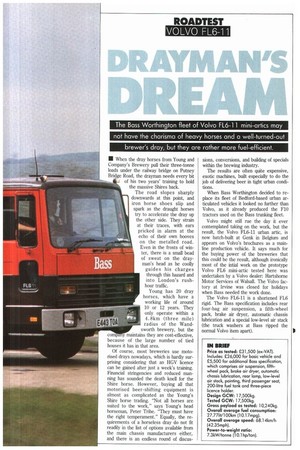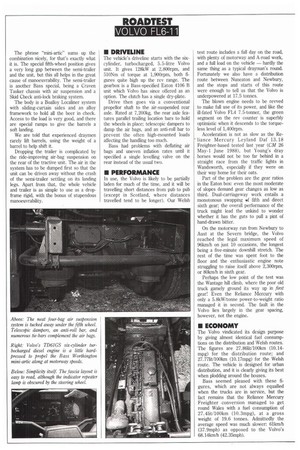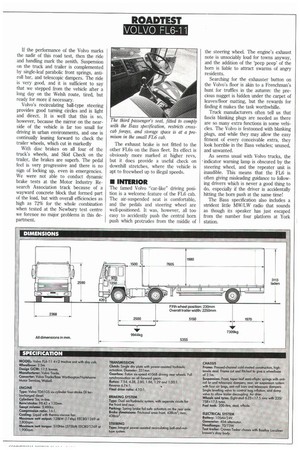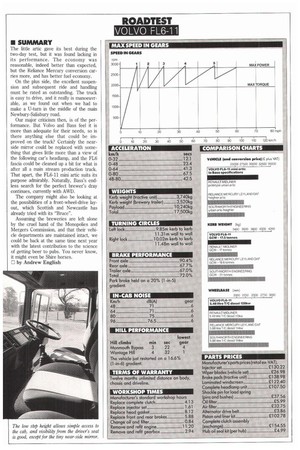The Bass Worthington fleet of Volvo FL6-11 mini-artics may not
Page 63

Page 64

Page 65

Page 66

If you've noticed an error in this article please click here to report it so we can fix it.
have the charisma of heavy horses and a well-turned-out brewer's dray, but they are rather more fuel-efficient.
• When the dray horses from Young and Company's Brewery pull their three-tonne loads under the railway bridge on Putney Bridge Road, the drayman needs every bit of his two years' training to hold the massive Shires back.
The road slopes sharply downwards at this point, and iron horse shoes slip and spark as the draught horses try to accelerate the dray up the other side. They strain at their traces, with ears pricked in alarm at the echo of their own hooves on the metalled road.
Even in the frosts of winter, there is a small bead of sweat on the drayman's head as he coolly guides his charges through this hazard and into London's rush hour traffic.
Young has 20 dray horses, which have a working life of around 10 or 12 years. They only operate within a 4,8km (three mile) radius of the Wandsworth brewery, but the Corns y maintains they are cost-effective, because of the large number of tied houses it has in that area.
Of course, most breweries use motorised drays nowadays, which is hardly surprising considering that an HGV licence can be gained after just a week's training. Financial stringencies and reduced manning has sounded the death knell for the Shire horse. However, buying all that motorised beer-shifting equipment is almost as complicated as the Young's Shire horse trading. "Not all horses are suited to the work," says Young's head horseman, Peter Tribe. "They must have the right temperament." Equally, the requirements of a horseless dray do not fit readily in the list of options available from the main chassis manufacturers either, and there is an endless round of discus sions, conversions, and building of specials within the brewing industry.
The results are often quite expensive, exotic machines, built especially to do the job of delivering beer in tight urban conditions.
When Bass Worthington decided to replace its fleet of Bedford-based urban articulated vehicles it looked no further than Volvo, as it already produced the F10 tractors used on the Bass trunking fleet.
Volvo might still rue the day it ever contemplated taking on the work, but the result, the Volvo FL6-11 urban artic, is now batch-built at Genic in Belgium and appears on Volvo's brochures as a mainline production vehicle. It says much for the buying power of the breweries that this could be the result, although ironically most of the intial work on the prototype Volvo FL6 mini-artic tested here was undertaken by a Volvo dealer: Hartshorne Motor Services of Walsall. The Volvo factory at Irvine was closed for holidays when Bass needed the work done.
The Volvo FL6-11 is a shortened FL6 rigid. The Bass specification includes rear four-bag air suspension, a fifth-wheel pack, brake air dryer, automatic chassis lubrication and a special low-level air stack (the truck washers at Bass ripped the normal Volvo item apart). The phrase "mini-artic" sums up the combination nicely, for that's exactly what it is. The special fifth-wheel position gives a very long gap between the semi-trailer and the unit, but this all helps in the great cause of manoeuvrability. The semi-trailer is another Bass special, being a Craven Tasker chassis with air suspension and a Skid Check anti-lock braking system.
The body is a Boalloy Localiner system with sliding-curtain sides and an alloy framework to hold all the beer in check. Access to the load is very good, and there are special ramps to give the barrels a soft landing.
We are told that experienced draymen rarely lift barrels, using the weight of a barrel to help shift it.
Dropping the trailer is complicated by the ride-improving air-bag suspension on the rear of the tractive unit. The air in the system has to be dumped first so that the unit can be driven away without the crash of the semi-trailer settling on its landing legs. Apart from that, the whole vehicle and trailer is as simple to use as a dropframe rigid, with the bonus of stupendous manoeuvrability.
• DRIVELINE
The vehicle's driveline starts with the sixcylinder, turbocharged, 5.5-litre Volvo unit. It gives 128kW at 2,800rpm, and 510Nm of torque at 1,900rpm, both figures quite high up the rev range. The gearbox is a Bass-specified Eaton 4106 B unit which Volvo has since offered as an option. The clutch has a single dry-plate.
Drive then goes via a conventional propellor shaft to the air-suspended rear axle. Rated at 7,200kg, the rear axle features parallel trailing location bars to hold the wheels in place; telescopic dampers to damp the air bags, and an anti-roll bar to prevent the often high-mounted loads affecting the handling too much.
Bass had problems with deflating air bags and uneven inflation rates until it specified a single levelling valve on the rear instead of the usual two.
• PERFORMANCE
In use, the Volvo is likely to be partially laden for much of the time, and it will be travelling short distances from pub to pub (except in Scotland, where distances travelled tend to be longer). Our Welsh test route includes a kill day on the road, with plenty of motorway and A-road work, and a full load on the vehicle — hardly the same thing as a typical drayman's round. Fortunately we also have a distribution route between Nuneaton and Newbury, and the stops and starts of this route were enough to tell us that the Volvo is underpowered at 17.5 tonnes.
The blown engine needs to be revved to make full use of its power, and like the ill-fated Volvo FL4 7.5-tonner, the green segment on the rev counter is superbly optimistic when it descends to the torqueless level of 1,400rpm.
Acceleration is not as slow as the Re' fiance Mercury Leyland Daf 13.18 Freighter-based tested last year (CM 26 May-1 June 1988), but Young's dray horses would not be too far behind in a straight race from the traffic lights in Wandsworth, especially if they were on their way home for their oats.
Part of the problem are the gear ratios in the Eaton box: even the most moderate of slopes demand gear changes as low as third. Dual-carriageway work entails a monotonous swapping of fifth and direct sixth gear; the overall performance of the truck might lead the unkind to wonder whether it has the guts to pull a pint of hand-drawn bitter.
On the motorway run from Newbury to Aust at the Severn bridge, the Volvo reached the legal maximum speed of 96km/h on just 10 occasions, the longest being a five-minute downhill stretch. The rest of the time was spent foot to the floor and the enthusiastic engine note struggling to raise itself above 2,300rpm, or 80km/h in sixth gear.
Perhaps the low point of the test was the Wantage hill climb, where the poor old truck gamely ground its way up in first gear! Even the Reliance Mercury with only a 5.8kW/tonne power-to-weight ratio managed it in second. The fault in the Volvo lies largely in the gear spacing, however, not the engine.
• ECONOMY
The Volvo vindicated its design purpose by giving almost identical fuel consumptions on the distribution and Welsh routes. The figures are 27.8611t/100km (10.14mpg) for the distribution route; and 27.77R/100km (10.17mpg) for the Welsh route. The vehicle is designed for urban distribution, and it is clearly giving its best when plodding around the houses.
Bass seemed pleased with these figures, which are not always equalled when the trucks are in service, but the fact remains that the Reliance Mercury Freighter conversion managed to get round Wales with a fuel consumption of 27.4lit/100km (10.3mpg), at a gross weight of 19.6 tonnes. Admittedly the average speed was much slower: 61km/h (37.9mph) as opposed to the Volvo's 68.141crn/h (42.35mph). If the performance of the Volvo marks the nadir of this road test, then the ride and handling mark the zenith. Suspension on the truck and trailer is complemented by single-leaf parabolic front springs, antiroll bar, and telescopic dampers. The ride is very good, and it is sufficient to say that we stepped from the vehicle after a long day on the Welsh route, tired, but ready for more if necessary.
Volvo's recirculating ball-type steering provides good turning circles and is light and direct. It is well that this is so, however, because the mirror on the nearside of the vehicle is far too small for driving in urban environments, and one is continually leaning forward to check the trailer wheels, which cut in markedly With disc brakes on all four of the truck's wheels, and Skid Check on the trailer, the brakes are superb. The pedal feel is very progressive and there is no sign of locking up, even in emergencies. We were not able to conduct dynamic brake tests at the Motor Industry Research Association track because of a wayward concrete block that formed part of the load, but with overall efficiencies as high as 72% for the whole combination when tested at the Newbury test centre we foresee no major problems in this department. The exhaust brake is not fitted to the other FL6s on the Bass fleet. Its effect is obviously more marked at higher revs, but it does provide a useful check on downhill stretches, where the vehicle is apt to freewheel up to illegal speeds.
• INTERIOR
The famed Volvo "car-like" driving position is a welcome feature of the FL6 cab. The air-suspended seat is comfortable, and the pedals and steering wheel are well-positioned. It was, however, all too easy to accidently push the central horn push which protrudes from the middle of the steering wheel. The engine's exhaust note is unsociably loud for towns anyway, and the addition of the 'peep peep' of the horn is liable to attract swarms of angry residents.
Searching for the exhauster button on the Volvo's floor is akin to a Frenchman's hunt for truffles in the autumn: the precious nugget is hidden under the carpet of leaves/floor matting, but the rewards for finding it makes the task worthwhille.
Truck manufacturers often tell us that fascia blanking plugs are needed as there are so many extra functions in some vehicles. The Volvo is festooned with blanking plugs, and while they may allow the easy fitment of every conceivable extra, they look horrible in the Bass vehicles; unused, and unwanted.
As seems usual with Volvo trucks, the indicator warning lamp is obscured by the steering wheel, and the repeater unit is inaudible. This means that the FL6 is often giving misleading guidance to following drivers which is never a good thing to do, especially if the driver is accidentally hitting the horn push at the same time!
The Bass specification also includes a strident little MW/LW radio that sounds as though its speaker has just escaped from the number four platform at York station.
• SUMMARY
The little artic gave its best during the two-day test, but it was found lacking in its performance. The economy was reasonable, indeed better than expected, but the Reliance Mercury conversion carries more, and has better fuel economy.
On the plus side, the excellent suspension and subsequent ride and handling must be rated as outstanding. The truck is easy to drive, and it really is manoeuvrable, as we found out when we had to make a U-turn in the middle of the main Newbury-Salisbury road.
Our major criticism then, is of the performance. But Volvo and Bass feel it is more than adequate for their needs, so is there anything else that could be improved on the truck? Certainly the nearside mirror could be replaced with something that gives little more than a view of the following car's headlamp, and the FL6 fascia could be cleaned up a bit for what is after all a main stream production truck. That apart, the FL6-11 mini artic suits its purpose admirably. Naturally, Bass's endless search for the perfect brewer's dray continues, currently with AWD.
The company might also be looking at the possibilities of a front-wheel-drive layout, which Scottish and Newcastle has already tried with its "Bruce".
Assuming the breweries are left alone by the cruel hand of the Monopolies and Mergers Commission, and that their vehicle departments are maintained intact, we could be back at the same time next year with the latest contribution to the science of getting beer to pubs. You never know, it might even be Shire horses.
0 by Andrew English




















































































































































